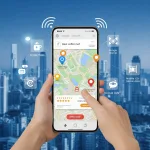Table of Contents
ToggleIntroduction
- In 2025, the way people search on Google is more location-aware than ever before. One of the most dominant trends is the rise of “near me” searches — like “coffee shops near me,” “emergency dentist near me,” or “best pizza near me open now.” These queries are highly intent-driven, meaning users are ready to act — whether that’s visiting a business, calling for a service, or making a purchase.
- The increasing use of smartphones, voice assistants, and Google Maps has transformed how businesses attract local customers. This makes “near me” SEO one of the most powerful tools in the digital marketing world today. If your business or content isn’t optimized for these queries, you’re missing out on a huge chunk of traffic that’s not just relevant — it’s urgent.
- This comprehensive guide breaks down the mechanics of “near me” Google searches, how they work in 2025, and most importantly, how you can optimize your digital presence to show up when and where people need you most.
1. What Are “Near Me” Google Searches?
1.1 Location-Based Search Queries
- “Near me” searches are user queries with built-in intent to find services or products close to their current location — e.g., “car wash near me” or “shoe repair near me.”
1.2 Intent to Take Action
- These searches often lead to immediate action — whether that’s getting directions, calling, or making a purchase — because they are time-sensitive and location-based.
1.3 Powered by Mobile and GPS
- Most of these searches happen on mobile devices with GPS enabled, allowing Google to tailor results precisely to the user’s location.
1.4 Key to Local Business Visibility
- For local shops, restaurants, clinics, and service providers, “near me” searches represent a critical opportunity to appear right when a potential customer is ready to act.
1.5 Google’s Algorithm Understands Context
- Google is now smart enough to show “near me” results even if users don’t type those words, interpreting search intent based on location data.
2. The Role of Google Maps in “Near Me” Searches
2.1 Default Map Listings
- Google often displays a 3-pack Map listing above regular organic results when it detects a local intent query.
2.2 Navigation Integration
- Users can instantly tap to get directions, view photos, or contact businesses right from the map results.
2.3 Ranking Within Google Maps
- Your business ranking in Maps is influenced by proximity, relevance, and prominence — including reviews and profile completeness.
2.4 Reviews Impact Visibility
- Businesses with higher ratings and more reviews are prioritized in the “near me” pack and Google Maps.
2.5 Integration with Voice Assistants
- When users ask voice assistants like Google Assistant for “something near me,” results often come directly from Google Maps data.
3. Local SEO and “Near Me” Optimization
3.1 Claim and Optimize Google Business Profile
- Ensure your GBP is claimed, verified, and filled out completely with accurate info, categories, and keywords.
3.2 NAP Consistency
- Maintain consistent Name, Address, and Phone Number across all directories and platforms.
3.3 Embed Local Keywords
- Use location-based terms naturally in your website content, headings, meta descriptions, and image alt tags.
3.4 Local Backlinks
- Acquire backlinks from other local businesses, newspapers, or community sites to boost local authority.
3.5 Build Out Service Area Pages
- Create landing pages for each city or neighborhood you serve with unique, localized content.
4. Voice Search and “Near Me” Queries
4.1 Conversational Queries Dominate
- People use natural language when speaking to devices — “Where’s the best Chinese food near me right now?”
4.2 Optimizing for Question-Based Searches
- Structure content to answer common questions using FAQ sections and semantic SEO.
4.3 Mobile-Friendly Is a Must
- Voice searches almost always happen on mobile — so fast, responsive design is essential.
4.4 Featured Snippets and Position Zero
- Voice assistants often read featured snippets — aim for structured content that’s eligible for snippets.
4.5 Schema for Voice Compatibility
- Use schema markup like LocalBusiness, Review, and FAQ to enhance your content’s visibility to voice AI.
5. Mobile Search and Location Targeting
5.1 Mobile Is the Primary Channel
- Over 80% of “near me” searches now come from mobile devices.
5.2 Enable Click-to-Call and Navigation
- Use call buttons, direction links, and action-focused CTAs for mobile users.
5.3 Mobile Page Speed
- Slow-loading sites will be penalized by Google and quickly abandoned by mobile users.
5.4 Localized Meta Titles
- Include location in your meta titles and descriptions to attract mobile users searching locally.
5.5 AMP and Responsive Design
- Using Accelerated Mobile Pages (AMP) and mobile-first design ensures smooth browsing on smartphones.
6. Google Business Profile and Its Impact
6.1 Complete Your Profile
- Fill in every field — business hours, photos, services, attributes (like “black-owned,” “wheelchair accessible”).
6.2 Add Products and Services
- List offerings in detail — this improves visibility for more keyword variations.
6.3 Update Posts Regularly
- Use Google Posts to share promotions, events, or updates — they appear in search results.
6.4 Collect and Respond to Reviews
- Encourage positive reviews and reply to them to show activity and credibility.
6.5 Enable Messaging
- Let customers message you directly through GBP — it’s convenient and improves engagement.
7. Google Ads and “Near Me” Paid Campaigns
7.1 Use Local Campaigns
- Google Ads offers campaign types specifically designed for local reach and store visits.
7.2 Radius Targeting
- Target ads to users within a specific distance from your business location.
7.3 Location Extensions
- Display your address and map on your ads to increase click-through rates.
7.4 Ad Scheduling for Local Intent
- Run ads during peak hours when people are most likely to search for “near me” services.
7.5 Track Offline Conversions
- Use Google Ads’ store visit conversion tracking to measure in-person results from online ads.
8. Keyword Research for “Near Me” Content
8.1 Use Google Keyword Planner
- Find keywords like “best gym near me” or “affordable dentist in [city].”
8.2 Long-Tail Modifiers
- Target specific terms: “open now,” “24/7,” “cheap,” “with parking,” “kid-friendly.”
8.3 Competitor Keyword Analysis
- See what terms local competitors are ranking for and use similar phrases.
8.4 Use Google Suggest
- Type part of your keyword and note Google’s autocomplete suggestions for popular terms.
8.5 Consider Intent Over Volume
- Some keywords with lower volume have very high conversion potential if intent is strong.
9. Structured Data for Local SEO
9.1 Use LocalBusiness Schema
- Add local schema markup to your website footer or contact page.
9.2 Include Review and Rating Schema
- This helps stars appear in search results, boosting click-through rates.
9.3 Mark Up FAQs
- Make Q&A content voice-search friendly and snippet-ready with FAQ schema.
9.4 Service Area Schema
- Use areaServed in your schema to tell Google which locations you target.
9.5 Use JSON-LD Format
- Google recommends using JSON-LD for structured data implementation.
10. Content Strategy for “Near Me” Searches
10.1 Create City-Specific Landing Pages
- Each page targets one city or neighborhood with custom content and SEO.
10.2 Write Localized Blog Content
- Write blogs like “Top 5 Spas in Downtown Austin” or “What to Expect at a Dentist in Queens.”
10.3 Use Listicles and Comparisons
- People love lists — use “Best gyms near me” and compare features, pricing, etc.
10.4 Include Location-Based FAQs
- Answer common location-related questions like hours, parking, accessibility.
10.5 Geo-Targeted Multimedia
- Use photos, maps, and videos tied to your local area to strengthen relevance.
11. Common Mistakes in “Near Me” SEO
11.1 Ignoring Google Business Profile
- Not optimizing GBP means missing out on top placement in map and search results.
11.2 Inconsistent NAP Data
- Inaccurate address or phone number can cause confusion and hurt trust.
11.3 Keyword Stuffing City Names
- Repeating city names unnaturally hurts readability and may trigger penalties.
11.4 Using Generic Content
- Avoid boilerplate text for different city pages — each page should be unique.
11.5 Not Tracking Results
- Use tools like Google Search Console and Google Analytics to track local performance.
12. Future of “Near Me” Searches in 2025
12.1 AI-Powered Local Results
- Google uses AI to personalize results based on behavior, not just location.
12.2 Predictive Local Search
- Search results show up before the user even types “near me,” based on patterns.
12.3 Augmented Reality Integration
- AR overlays in Google Maps show reviews and directions in real time.
12.4 Deeper Smartwatch Integration
- Voice-based searches and directions from wearables are more common.
12.5 Privacy and Data Concerns
- As personalization grows, expect users to care more about how location data is used.
13. Case Studies and Success Stories
13.1 Restaurant Boosts Traffic with Google Reviews
- A local diner tripled their weekday footfall just by optimizing their GBP and asking for reviews.
13.2 Local Plumber Uses Voice Search Strategy
- By targeting “plumber near me open now,” they gained emergency leads every night.
13.3 Clothing Store Runs Radius Ads
- A boutique ran a 5km ad radius targeting people at nearby shopping centers with strong ROI.
13.4 Fitness Blog Targets “Near Me” Keywords
- A blog about fitness studios saw massive traffic after writing geo-specific workout guides.
13.5 Freelancer Dominates Local SEO
- A photographer used city pages and GBP reviews to rank #1 in multiple cities.
14. Checklist to Dominate “Near Me” Searches
14.1 Claim & Optimize Google Business Profile
- Make sure every field is filled and up to date.
14.2 Create Local Landing Pages
- Don’t just rely on your homepage — build local silos.
14.3 Use Voice and Mobile Optimization
- Design for speed, usability, and conversational search.
14.4 Incorporate Schema Markup
- Structured data helps Google understand your local relevance.
14.5 Encourage and Manage Reviews
- Positive reviews = more trust = higher visibility.
Conclusion
- “Near me” searches have redefined how people discover and choose businesses. In 2025, these hyper-local, high-intent queries are no longer just a bonus — they’re a necessity for any brand looking to grow. Whether you run a local store, provide services, or write a content blog — optimizing for “near me” Google searches will increase your traffic, conversions, and revenue.
- By following the strategies outlined in this guide — from Google Business optimization to voice search readiness — you can stay ahead in the evolving local SEO landscape. Don’t wait for your competitors to outrank you. Take control of your local presence now and become the top result when someone searches “near me.”






